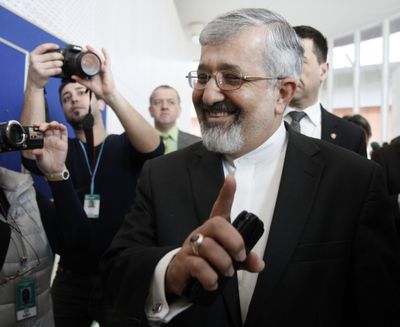Experts suspicious of possible Iran cleanup
Some suggest site may be tied to bomb development

VIENNA – Satellite images of an Iranian military facility appear to show trucks and earth-moving vehicles at the site, indicating an attempted cleanup of radioactive traces possibly left by tests of a nuclear-weapon trigger, diplomats told the Associated Press on Wednesday.
The assertions from the diplomats, all nuclear experts accredited to the International Atomic Energy Agency, could add to the growing international pressure on Iran over its nuclear program, which Tehran insists is for peaceful purposes.
While the U.S. and the EU are backing a sanctions-heavy approach, Israel has warned that it may resort to a pre-emptive strike against Iran’s nuclear facilities to prevent it from obtaining atomic weapons.
Two of the diplomats said the crews at the Parchin military site may be trying to erase evidence of tests of a small experimental neutron device used to set off a nuclear explosion. A third diplomat could not confirm that but said any attempt to trigger a so-called neutron initiator could only be in the context of trying to develop nuclear arms.
The diplomats said they suspect attempts at sanitization because some of the vehicles at the scene appeared to be haulage trucks and other equipment suited to carting off potentially contaminated soil from the site.
The images, provided by member countries to the IAEA, the U.N’s nuclear watchdog, are recent and constantly updated, one of the diplomats said. The diplomats all requested anonymity because they were not authorized to discuss the information on the record.
The IAEA has already identified Parchin as the location of suspected nuclear weapons-related testing. In a November report, it said it appeared to be the site of experiments with conventional high explosives meant to initiate a nuclear chain reaction.
It did not mention a neutron initiator as part of those tests, but in a separate section cited an unnamed member nation as saying Iran may have experimented with a neutron initiator, without going into detail or naming a location for such work.
In contrast, the intelligence information shared with the AP by the two diplomats linked the high-explosives work directly to setting off a neutron initiator at Parchin.
One official from an IAEA member country with good intelligence on Iran said the Parchin neutron initiator experiments were conducted between 2003 and 2010. Another said any such tests were closer to 2003, adding it was not clear whether they were successful.
The timing is important.
U.S. intelligence officials say they generally stand by a 2007 intelligence assessment that asserts Iran stopped comprehensive secret work on developing nuclear arms in 2003. But Britain, France, Germany, Israel and other U.S. allies think such activities have continued past that date, a view shared by the IAEA.
Iran vehemently denies allegations that it conducted any research and development into atomic weapons.
Asked for comment, Ali Asghar Soltanieh, Iran’s chief delegate to the IAEA, told the AP he would not discuss any nuclear issues until after he delivered his statement at the agency’s 35-nation board meeting today.